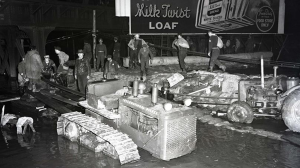To Hollywood, construction sites are places for criminals to hide and heroes to ransack — action-packed settings for comedy, romance, horror or animated mayhem. Where did Hollywood’s attention to serious research and realism go? Out the 23rd-floor window, along with the stuntman, who just used it as a convenient escape route. Some prime examples:
MOVIES
How Hollywood’s entertainment industry uses construction settings for multiple film genres
Correspondent
TORONTO
To Hollywood, construction sites are places for criminals to hide and heroes to ransack — action-packed settings for comedy, romance, horror or animated mayhem. Where did Hollywood’s attention to serious research and realism go? Out the 23rd-floor window, along with the stuntman, who just used it as a convenient escape route. Some prime examples:
• A Dream Walking (1934) — Popeye and arch-enemy Bluto come to blows while competing to save sleep-walking Olive Oyl from toppling off a construction project. Great set-pieces involve narrow escapes from machinery in motion. Best line: Wimpy telling distraught Popeye not to worry, “She will awaken when she falls.”
Other construction themed-cartoons include Rhapsody in Rivets (1941) and Homeless Hare (1950) in which Bugs Bunny squares off against burrow-destroying construction workers.
• Steel Against the Sky (1942) — Suspension bridge building, 1940s style. Brothers Rocky (Lloyd Nolan) and Chuck (Craig Stevens) compete on the job site and off, occasionally for the hand of love interest Helen (Alexis Smith). Can the boys cooperate long enough to finish a major construction project before a big winter storm sets in? Safety inspectors, cover your eyes: no fall arrest devices were used in the making of this film.
• How High is Up? (1940) — The Three Stooges, Moe Howard, Curly Howard and Larry Fine, are caught punching holes in construction workers’ lunch-boxes to drum up business for their lunch-box repair service. To escape, they enlist as incompetent riveters on a high rise construction project. The Stooges were actually experienced contractors, having also appeared as destructive plumbers, painters, plasterers and electricians.
• The Fighting Seabees (1944) — John Wayne stars as Wedge Donovan, a civilian construction foreman beset by enemy soldiers as his crew builds Pacific Island air bases during World War II. America’s real-life solution: create Navy Construction Battalions (Seabees) capable of fighting back. Entertaining war propaganda, including an exciting climax as the Seabees fight an enemy onslaught with cranes and bulldozers alone. Okay … they also use guns and grenades.
• The Ten Commandments (1956) — Sure, Moses (Charlton Heston) presides over the parting of the Red Sea, but watch him take on the role of the original champion of construction labourers working on a pet city-building project for the Egyptian Pharaoh. More grain breaks, fewer beatings, and one day off per week do wonders for worker morale and the project schedule, despite criticism from naysayer Rameses (Yul Brynner).
• Killdozer (1974) — Hardhats working on a remote African island are beset by a Caterpillar D-9 bulldozer struck by a glowing alien meteorite. These guys aren’t the industry’s brightest — how else do you explain a 10-ton diesel sneaking up on the crew — but foreman Lloyd Kelly (Clint Walker) eventually mounts a construction-savvy counter-offensive. Originally a 1944 short story by Theodore Sturgeon.
• Steel (1979) — Shot on an actual building site in Lexington, Kentucky, this film follows the efforts of a crack construction crew to complete a high rise in three weeks, despite corporate sabotage and the “construction anxiety” of legendary foreman Lee Majors, who once froze atop a big job.
Typical construction site hijinks: crane-lifting an occupied outhouse for laughs.
• The Carpenter (1989) — Canada’s contribution to construction cinema. After Ed the carpenter (Wings Hauser) goes over budget, he kills the repro men who try to repossess his lumber. The cops kill Ed who returns from the dead to complete the job, eliminating anyone who messes with his schedule. Part of an ignoble tradition of construction/horror films including infamous entries, The Toolbox Murders (1978) and The DrillerKiller (1979).










Recent Comments
comments for this post are closed